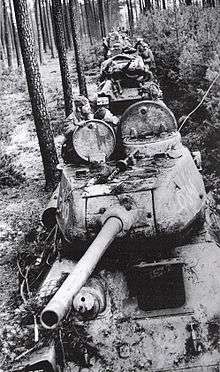3rd Guards Tank Army (Soviet Union)
| 3rd Guards Tank Army 3rd Guards Mechanised Army (1946-57) 3rd Guards Tank Army (1957-67 18th Guards Army (1967-79) | |
|---|---|
 | |
| Active | 1942 - 1979 |
| Country |
|
| Branch |
|
| Type | Armoured |
| Role | Breakthrough and Exploitation in Deep Operations |
| Size | 500 - 800 tanks |
| Part of | Moscow Military District |
| Engagements | |
| Commanders | |
| Notable commanders | General Colonel Pavel Rybalko |
The 3rd Guards Tank Army (Russian: 3-я гвардейская танковая армия) was a tank army established by the Soviet Union's Red Army during World War II. The 3rd Tank Army was created in 1942 and fought in the southern areas of the Soviet Union, Poland, Germany, and Czechoslovakia until the defeat of Germany in 1945. Postwar, the army served as occupation troops in East Germany, went through several name changes, and was finally deactivated in 1979.
History
Great Patriotic War (World War Two)
First Formation

The 3rd Tank Army was formed as part of the Reserve of the Supreme High Command (RVGK, Stavka reserve) on the basis of the 58th Army in the Moscow Military District in May 1942. It was placed under the command of General Lieutenant P. L. Romanenko. Its initial composition was 12th and 15th Tank Corps (later to become 6th and 7th Guards Tank Corps), one motor rifle division, and two rifle divisions. As part of the Soviet Western Front, the 3rd Tank Army successfully counter-attacked the German Second Panzer Army in August 1942. Soon afterwards, in September 1942, Romanenko handed over to General Colonel P. S. Rybalko, who held command of the Army for the remainder of the war.
Committed to the fighting for Kharkov in March 1943 as part of the Voronezh Front, the 3rd Tank Army was subsequently encircled and virtually destroyed by German forces. The Army's remnants were reorganised as the 57th Army.
Second Formation
The army was reformed as the 3rd Guards Tank Army in May 1943, including the 9th Mechanised Corps & 12th & 15th Tank Corps. In 1943, the army took part in the Orel offensive and, assigned to the Voronezh and First Ukrainian Fronts, played a leading role in the liberation of Left Bank Ukraine. The army was among the first Soviet troops to reach the Dnieper River in October 1943. In 1944, it fought in the Proskurov-Chernovits and Lvov-Sandomierz offensive operations. The army subsequently fought in southern Poland, Silesia, and in the Battle of Berlin. It overran the OKH command post at Zossen, headquarters for German Eastern Front operations, on April 21, 1945. Finally, the army drove on Prague, entering that city on May 9.
Cold War
By 1946, the army had been re-designated as the 3rd Guards Mechanized Army and was headquartered in Luckenwalde, East Germany, as part of the Group of Soviet Forces in Germany. The 3rd Guards Mechanized Army was one of several Soviet armies used in the suppression of the 1953 uprising in East Germany, moving the 6th Guards Tank Division into Dessau and Wittenberg as well as the 9th Mechanized Division into Lubben, Cottbus, and Spremberg.[1] In 1957, the army was renamed the 3rd Guards Red Banner Tank Army and then again renamed as the 18th Guards Red Banner Army in 1957.
Up to 1967 it had preserved two formations which had served with it during World War II: the 6th and 7th Guards Tank Divisions (former similarly numbered Tank Corps).[2] Its third formation - 82nd Motor Rifle Division (the former 9th MD, former 9th MK) was in 1958 withdrawn to the USSR and disbanded, and instead the 14th Guard MD was included (former 9th Guards, named for a short period the 116th Rifle Division).
Withdrawn to Alma-Ata in 1979, the army became an operational group and then was used to activate Headquarters Central Asian Military District.[3]
Notes
- ↑ "17. Juni 1953 - Situation Report from Andrei Grechko and A. Tarasov". 17juni53.de.
- ↑ V.I. Feskov et al 2004.
- ↑ "Soviet Armed Forces 1945-1991". ww2.dk.
References
- Born, Keith E. (ed.) Slaughterhouse. Bedford: Aberjona Press, 2005. ISBN 0-9717650-9-X.
- Glantz, David M. Companion to Colossus Reborn. Lawrence: University Press of Kansas, 2005. ISBN 0-7006-1359-5.
- Poirier, Robert G., and Conner, Albert Z. The Red Army Order of Battle in the Great Patriotic War. Novato: Presidio Press, 1985. ISBN 0-89141-237-9.